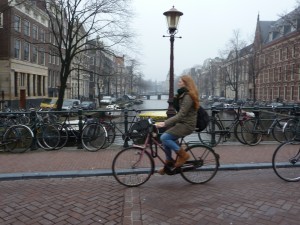
Miranda Devine had a rant this week about cyclists:
But hostilities were fed by the lies told by the Government and the RTA, which gave cyclists unreasonable expectations and ideas above their station. The former roads minister Carl Scully, a vegetarian cyclist, threw $250 million at the lobby, further fuelling expectations which were dashed by subsequent roads ministers.
Most bike paths turned out to be little more than white paint on a road, with no room for a bike between parked cars and traffic. But they sent a signal to cyclists that motorists were somehow in the wrong.
In Devine’s view, it seems the fact that cycle paths were promised and then built so badly that they are dangerous and force cyclists on to the roads is proof that the cycle paths should never have been built at all (she has a slightly more balanced view today, calling for courtesy from everyone).
I was pondering this as I went on my first bike ride of the summer today. I am normally an overly conscientious rule follower. If there is a rule, I know about it, and follow it. Daggy, I know. But put me on a bike, and I become the person who convinces themselves that the rules are stupid, and I am trustworthy enough to break them. For example, today I rode my bike for 10 metres on the footpath to avoid about 200m of busy traffic filled road that was a bit too scary for my current inexperienced biking state. I rode at a maximum of 10km an hour, and easily avoided the two people walking towards me.
But I broke the law.
Many cyclists go much further, and do quite dangerous things (to pedestrians – I still find it pretty hard to understand the motorist who is scared of cyclists). I know, I’ve been knocked down by a cyclist while I was a pedestrian. But the problem is that nearly anywhere you go in Sydney, while you are safe for most of your journey, there are spots where your choice is to do something illegal (but safe) or something legal, and much less safe. Cyclists get into the habit of breaking the law because the infrastructure makes it so hard for them to obey it. And then they get to the sense of entitlement that sees them knocking pedestrians over on the footpath. The local mayor says that gaps in cycleways are what caused the incident that got Devine so hot under the collar.
I’m never quite sure how far cycling can go in becoming a serious form of transport in Sydney – it’s very hilly, and hot and humid in summer. But it’s a bit silly blaming only the cyclists for their bad behaviour when the road system almost forces them to break the law.

I wonder if allowing cyclists to use footpaths but saying that they must always give way to other footpath users would work, and ride at no more than walking pace. That way there’s a disincentive for cyclists to use footpaths (much slower than the road, liable for any injuries they inflict, whether they cause them or not, because if they have to give way then by definition they must be at fault in an accident), so cyclists would only use the footpaths at need, but they could legitimately use footpaths for safety.
I used to bike a lot when we lived in Canberra – I loved all those safe bikepaths, and I biked a bit in Palmerston North (NZ) – wide roads, not much traffic, a biking culture with respect to getting to and from the university. Never in Wellington, and not yet in Adelaide. But I hope to… next year.
Yes, I am the classic law-follower who still goes thru the occasional red light as a cyclist (only if it’s a T-intersection and I’m on the non-intersecting side of the road) and will ride on footpaths or in parks … eseentially I do it in order to stay alive! And I’m very careful and considerate of pedestrians. I thought Devine’s piece was awful (of course) – a licence to motorists to be dangerous to cyclists.
Miranda Devine is just a troll who has escaped from the internet and infested a newspaper. A good topic introduction for writing a real opinion, but no more.
Your point about breaking the rules also applies to security, strangely enough – if you make it too hard to follow the security rules, people find ways to get around them (so they can get something done), so your system can become less secure as you add more restrictions.